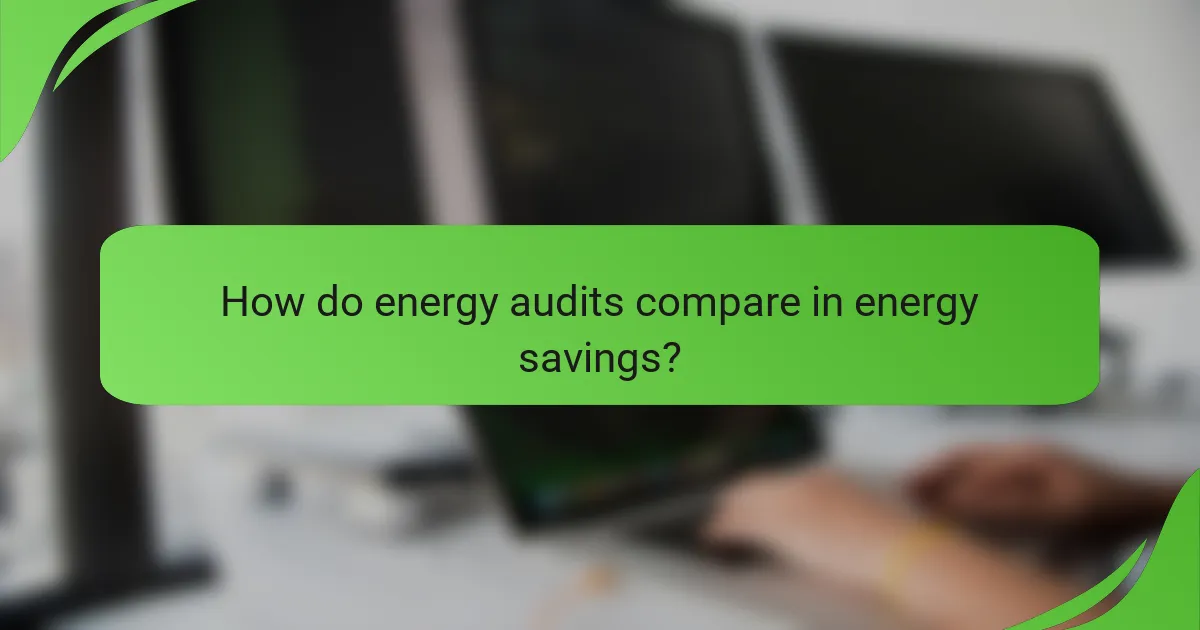Green building energy audits play a crucial role in enhancing sustainability by identifying opportunities for energy savings and efficiency improvements. These audits come in various types, each tailored to assess a building’s energy use and pinpoint specific areas for optimization. Comprehensive audits typically reveal more extensive savings compared to targeted approaches, making them essential for creating economically viable and environmentally friendly structures.

What are the benefits of energy audits for green buildings?
Energy audits for green buildings provide significant advantages, including cost savings, improved efficiency, and enhanced comfort for occupants. By identifying areas for energy reduction and optimization, these audits help to create more sustainable and economically viable structures.
Cost savings on energy bills
One of the primary benefits of energy audits is the potential for substantial cost savings on energy bills. By pinpointing inefficiencies, building owners can implement targeted upgrades that often lead to reductions in energy consumption of 10-30% or more.
Common upgrades include improving insulation, replacing outdated HVAC systems, and installing energy-efficient lighting. These changes not only lower monthly expenses but can also lead to quick returns on investment.
Improved building performance
Energy audits enhance overall building performance by optimizing systems and ensuring they operate at peak efficiency. This includes evaluating heating, cooling, and ventilation systems to identify opportunities for improvement.
Regular audits can help maintain equipment longevity and reduce the frequency of repairs, ultimately leading to a more reliable and efficient building environment.
Enhanced occupant comfort
Energy audits contribute to enhanced occupant comfort by addressing issues such as temperature fluctuations, air quality, and noise levels. By optimizing energy systems, buildings can maintain consistent temperatures and improve indoor air quality.
Comfortable environments not only boost productivity but can also lead to higher tenant satisfaction and retention rates, making it a critical aspect of building management.
Increased property value
Implementing the recommendations from energy audits can significantly increase a property’s market value. Energy-efficient buildings are often more attractive to buyers and tenants, as they promise lower operating costs and a reduced environmental footprint.
Investing in energy efficiency can yield returns of 5-10% or more on property value, making it a wise financial decision for property owners.
Compliance with regulations
Energy audits help ensure compliance with local and national energy regulations, which are becoming increasingly stringent. Many jurisdictions require energy assessments for commercial buildings, and audits can help meet these legal obligations.
By staying compliant, building owners can avoid potential fines and penalties while also benefiting from incentives and rebates available for energy-efficient upgrades.

How do energy audits compare in energy savings?
Energy audits vary significantly in their potential for energy savings, depending on the type of audit conducted and the specific characteristics of the building. Generally, comprehensive audits tend to identify more extensive savings opportunities compared to targeted audits, which focus on specific areas of concern.
Residential vs. commercial audits
Residential energy audits typically emphasize energy efficiency improvements that can be made in single-family homes, such as insulation upgrades, HVAC system enhancements, and appliance replacements. These audits often lead to savings ranging from 10% to 30% on energy bills.
In contrast, commercial audits assess larger buildings and may involve more complex systems, including lighting, heating, and cooling. The potential savings in commercial settings can be more substantial, often exceeding 30%, due to the scale of operations and the variety of systems in place.
Comprehensive audits vs. targeted audits
Comprehensive audits evaluate all aspects of a building’s energy use, providing a holistic view of potential savings. These audits often uncover opportunities for significant improvements, such as upgrading insulation, sealing leaks, and optimizing energy management systems.
Targeted audits focus on specific issues, such as high energy bills or equipment performance. While they can provide quick fixes, the savings identified may be less impactful than those found in comprehensive audits. Businesses should weigh the cost of each type against their specific needs to determine the best approach.
Impact of building age on savings
The age of a building plays a crucial role in determining energy savings from audits. Older buildings often have outdated systems and poor insulation, which can lead to higher potential savings when modern upgrades are implemented. For instance, retrofitting an older building can yield savings of 20% to 50% compared to its current energy consumption.
Newer buildings, designed with modern energy efficiency standards, may have less room for improvement. However, they can still benefit from audits to optimize existing systems and ensure compliance with current regulations. Understanding the age-related context can help prioritize upgrades and maximize savings.

What types of energy audits are available?
Energy audits come in various types, each designed to assess a building’s energy use and identify opportunities for savings. The main types include walkthrough audits, energy analysis audits, and investment-grade audits, each varying in depth and detail.
Level 1: Walkthrough audit
A walkthrough audit is a basic assessment where an auditor visually inspects the building to identify obvious energy-saving opportunities. This type typically involves checking insulation, lighting, and HVAC systems without detailed measurements.
Building owners can expect recommendations for low-cost improvements, such as switching to LED lighting or sealing air leaks. This audit is often the first step for organizations looking to enhance energy efficiency without significant investment.
Level 2: Energy analysis audit
The energy analysis audit provides a more detailed examination of energy consumption patterns using data collection and analysis. This audit typically involves monitoring energy usage over time and may include software modeling to predict savings from proposed upgrades.
Organizations can expect a comprehensive report outlining specific areas for improvement, potential savings, and a cost-benefit analysis. This type of audit is suitable for businesses looking to make informed decisions about larger energy efficiency investments.
Level 3: Investment-grade audit
An investment-grade audit is the most thorough type, designed to provide detailed financial analysis and technical specifications for energy-saving projects. This audit involves extensive data collection, including energy bills, equipment specifications, and operational practices.
Results from this audit typically include a clear financial justification for investments, such as return on investment (ROI) calculations and payback periods. Companies considering significant upgrades or seeking financing will benefit from this level of audit, as it provides the necessary documentation for stakeholders and lenders.

Which energy audit is best for my building?
The best energy audit for your building depends on its size, age, and specific energy efficiency goals. A comprehensive understanding of your building’s energy usage will help you choose the most suitable audit type to maximize savings and improve performance.
Factors influencing audit choice
Cost considerations for different audits
Expected ROI from each audit type

How do local regulations affect energy audits?
Local regulations significantly influence energy audits by establishing the standards and requirements that must be met for compliance. These regulations can dictate the scope of the audit, the methodologies used, and the types of improvements that qualify for incentives or rebates.
State-specific energy efficiency programs
Many states offer energy efficiency programs that provide guidelines and financial support for conducting energy audits. These programs often include incentives for implementing energy-saving measures identified during the audit process. For instance, states like California and New York have robust programs that encourage residential and commercial buildings to improve their energy performance.
When participating in state-specific programs, it’s essential to understand the eligibility criteria and the types of audits recognized. Some states may require audits to be performed by certified professionals to qualify for rebates or incentives, ensuring that the findings are reliable and actionable.
Incentives for green building certifications
Local regulations often include incentives for achieving green building certifications, such as LEED or BREEAM. These incentives can take the form of tax credits, grants, or expedited permitting processes, which can significantly reduce the overall cost of energy audits and subsequent improvements.
To maximize benefits, property owners should research the specific certifications recognized in their area and the associated incentives. Engaging with local authorities or energy efficiency organizations can provide valuable insights into available programs and help streamline the certification process, making it easier to achieve energy savings and sustainability goals.

What tools are used in energy audits?
Energy audits utilize a variety of tools to assess a building’s energy efficiency and identify potential savings. These tools range from simple handheld devices to advanced software that analyzes energy consumption patterns.
Blower Door Test
The blower door test measures a building’s airtightness by using a fan to depressurize the space. This helps identify air leaks, which can significantly impact energy efficiency. Typically, a well-sealed building will have a leakage rate of less than 0.35 air changes per hour.
During the test, the fan is mounted in an exterior door frame, and the pressure difference created allows auditors to pinpoint areas where air is escaping. Common leak locations include windows, doors, and ductwork.
Thermal Imaging Camera
A thermal imaging camera detects heat loss by visualizing temperature differences across surfaces. This tool is particularly effective in identifying insulation deficiencies and air leaks that are not visible to the naked eye.
When using a thermal camera, auditors can quickly scan walls, ceilings, and floors to find cold spots that indicate poor insulation or leaks. This method can lead to targeted improvements that enhance energy efficiency.
Energy Monitoring Software
Energy monitoring software tracks and analyzes a building’s energy consumption over time. This tool provides insights into usage patterns and helps identify opportunities for savings.
By integrating data from various sources, such as smart meters and HVAC systems, this software can generate reports that highlight peak usage times and suggest strategies for reducing energy costs. Many systems offer user-friendly dashboards for easy interpretation of data.
Utility Bill Analysis
Analyzing utility bills is a fundamental step in energy audits. This process involves reviewing historical energy consumption and costs to identify trends and anomalies.
Auditors typically look for spikes in usage that may indicate inefficiencies or equipment malfunctions. Comparing bills over different seasons can also reveal how well a building performs under varying conditions, guiding future energy-saving measures.
